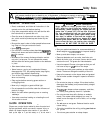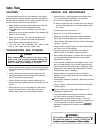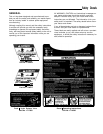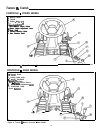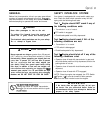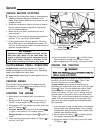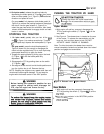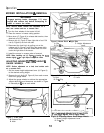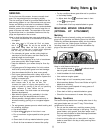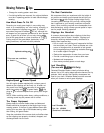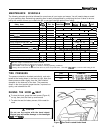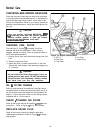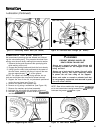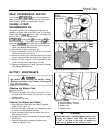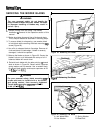
GENERAL
For the first use of the mower, choose a smooth level
area. Cut long straight strips overlapping slightly.
The size and type of area to be mowed determines the
best mowing pattern to use. Obstructions such as trees,
fences and buildings must also be considered. Where
possible, make one or two passes in a counterclockwise
direction around the outside of the area to keep the cut
grass off fences and walks. The remainder of the mow-
ing should be done in a clockwise direction so the clip-
pings are dispersed on the cut area.
Keep in mind the following lawn care and mowing tips:
l Too much maintenance is as detrimental to your lawn
as neglect.
l Mow when grass is 3-5 inches tall. Don’t cut shorter
than 2 to
2-l/2
inches. Cut only the top one-third of the
grass blade. Cutting below this level can lead to thatch
problems. Your mower has a cutting height adjustment
that can help you maintain a proper length.
l For extremely tall grass, set the cutting height at
maximum for the first pass, and then reset to the
desired height and mow again.
l Mow often. Short clippings of an inch or less decom-
pose more quickly than longer blades.
l Keep the blades on your mower sharp for finer clip-
pings.
l Let grass grow a bit longer when it is hot to reduce
heat build-up and protect grass from heat damage.
l Use slow-release fertilizer for slow, even growth.
l Don’t cover grass surface with a heavy layer of clip-
pings. Consider using a grass collection system and
starting a compost pile.
l Aerate lawn in spring, consider renting an aerator
which removes cores of soil from the lawn. This
increases the speed of clipping decomposition and
deep root growth by opening up the soil and permitting
greater movement of water, fertilizer and air.
l Don’t over-water. Too much water can encourage
disease development.
l Mow when the grass is dry, preferably in the late
afternoon when the temperatures are cooler.
l Where possible, change patterns occasionally to
eliminate matting, graining or a corrugated appear-
ance.
l For wet grasses, grasses prone to wheel tracking and
for collecting clippings:
a. Use sharp blades.
b. Adjust deck
l/4” higher in front than in rear.
c. Run at maximum engine speed but slow ground
speed.
d. Clean deck of built-up material/caked-on grass.
e. Check for free movement of mower idler pulley.
Mowing Patterns & lips
l For dry conditions where grass blow-out is a problem:
a. Use sharp blades.
b. Adjust deck flat to
l/8”
maximum lower in front.
c. Use
314
engine speed.
d. Clean deck of built-up material/caked-on grass.
MULCHING MOWER OPERATION
(OPTIONAL KIT ATTACHMENT)
Mulching
Mulching consists of actually cutting and recutting clip-
pings into tiny panicles and blowing them into the lawn.
These tiny particles decompose rapidly into by-products
your lawn can use. Under proper conditions, your
mulching mower will virtually eliminate noticeable clip-
pings on the lawn surface.
Keep in mind these mulching tips:
l Use mulching mower or
mulcher kit without shred-
ders for grass mulching.
l Install shredders for leaf shredding.
l Use maximum engine speed.
l Raise height of cut if excessive power is used.
l Must use sharp blades. Do not use lift tabs or high lift
blade when mulching.
l Adjust to lower ground speeds in heavy grass or if
wind rowing is present.
l Clean deck of built-up material/caked-on grass.
l Check for free movement of mower idler pulley.
Mowing Conditions
The best mulching results from mowing when lawn is dry
and grass blades are not over 5” long. Follow these
guidelines for best results:
l Do not use the mower as a mulching mower during
the first two or three mowings in the spring. The long
grass blades, quick growth, and often wetter condi-
tions are more suitable for side-discharge (broadcast-
ing) or grass bagging operation.
l Avoid mulching after rain or heavy dew. It may be
better to mow later in the day or early evening when
lawn is drier.
11



